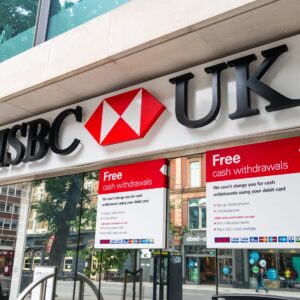


Barclays mortgage borrowers offered discounted energy-efficiency check
Borrowers will be offered a British Gas Home Health Check for a discounted price, along with a free EPC to help improve their home’s energy efficiency.
The deal follows research by the bank that found that, while 70% of homeowners would like their homes to be more energy efficient, 35% said they were dissuaded from making energy-efficient improvements because they did not understand which upgrades were right for their property.
Meanwhile, just over 30% of homeowners said they did not have an up-to-date EPC, and nearly half said they would benefit from personalised recommendations to make their home more energy efficient.
Barclays borrowers can get a Home Health Check for £50 instead of the standard price of £99 and receive the EPC for free instead of paying £20.
‘Personalised recommendations’
The Home Health Check provides an in-home survey, during which an accredited domestic energy assessor analyses how energy is used in the customer’s home. The assessor then provides personalised guidance on ways the customer could lower their energy bills, reduce their energy consumption and make their homes more efficient. This includes recommendations to make existing systems more efficient at low or no cost where possible, as well as recommending new solutions.
The partnership is part of Barclays’ Greener Homes Strategy and builds on the existing relationship between Barclays and British Gas.
Nick Stace, head of sustainable finance at Barclays UK, said: “Aside from the upfront cost, one of the major barriers our customers face when trying to make their home more energy efficient is confusion about which of the various upgrades are right for their property. Through our ongoing partnership with British Gas, we want to help overcome this barrier by providing customers with personalised recommendations for saving money and potentially reducing their energy consumption.”
“We also want to help incentivise those changes, through schemes such as the Barclays Greener Home Reward, which gives a cash reward of up to £2,000 to UK residential mortgage customers who install a qualifying home energy-efficiency improvement.”



Virgin Money ups rates; Skipton BS lowers rates – round-up
On Virgin Money’s exclusive remortgage side, the lender has added Fix and Switch deals with a two-year early repayment charge (ERC) at 85% loan to value (LTV).
Its five-year fixed rate with a £1,495 fee starts at 5.54%, and the fee-saver option starts at 5.89%.
Virgin Money will also make several rate changes from 8pm on 30 April.
The lender’s Fix and Switch purchase rates at 85% and 90% LTV will be increased by up to 0.1%, with pricing beginning from 5.27%.
The firm’s Fix and Switch remortgage rates at 75% LTV will rise by 0.1% and start from 5.09%.
Virgin Money’s BTL Fix and Switch rates at 60% and 75% LTV will go up by 0.15%, starting from 5.07%.
The lender’s 90% LTV exclusive purchase fixed rates will rise by up to 0.08%, with rates beginning from 4.87%.
Selected exclusive remortgage fixed rates will be increased by up to 0.16%, starting from 4.54%, and large loan exclusive purchase and remortgage fixed rates will rise by up to 0.2%, beginning from 4.9%.
Exclusive BTL fixed rates will increase by up to 0.1%, starting from 4.07%, and selected product transfer fixed rates will rise by up to 0.1%, beginning from 4.43%.
Skipton BS cuts rates and adds deals
Skipton Building Society will reduce rates in its residential range, cut its track record mortgage and reintroduce high-loan-to-value (LTV) fixed residential remortgage deals.
The mutual is introducing rate reductions from tomorrow, 1 May, with fixed and tracker rate products impacted.
Selected two-year fixed residential products have been cut, and its track record mortgage has gone down from 5.65% to 5.55%.
The mutual has reintroduced higher-LTV remortgage options, including residential 85% and 90% LTV fixed rate remortgage products, along with fee products in its fixed purchase range.



Purplebricks launches mortgage firm with access to ‘market-leading’ deals
This change will see more than 150 employees working under the Purplebricks Mortgages name, allowing customers of the estate agency group to receive an end-to-end homebuying service through its platform.
The firm said customers could now undergo the complete purchase journey with Purplebricks, from viewing a property to purchasing.
It will also provide in-house access to market-leading mortgage rates, the company said.
Purplebricks sold its trading business and assets to Strike last year for a consideration of £1.
Strike’s subsidiary Strike Financial Services has facilitated more than 315 mortgages per month so far this year, and it has seen 1,150 mortgages offered within 16 days.
Of these, 300 mortgages were issued to first-time buyers, which Purplebricks said highlighted its expertise in this market.
‘Next stage of our evolution’
Joanne Pocklington, managing director of Purplebricks Mortgages, said: “Moving to the Purplebricks name is the next stage of our evolution in the group. Over the past three years, Strike Financial Services has become one of the UK’s leading mortgage advisers, recently winning Top Business for Quality at the Mortgage Advice Bureau Awards 2024. The process of finding the right mortgage is critical to supporting the growth in homeownership in the UK.
“At Purplebricks Mortgages, we innately understand the housing market and use this expertise to benefit our customers every day. Not only can customers get the right deal, we’ve also streamlined the house buying process with Purplebricks to allow everything to be done under one umbrella.”
Pocklington was appointed operations director at Strike in 2022. Before that, she worked at London and Country Mortgages for five-and-a-half years, most recently as head of operations. Prior to this, she worked at Alexander Hall for nearly 16 years.
Sam Mitchell, CEO of Purplebricks, added: “The teams at Purplebricks and Strike will leverage their experience and knowledge in the property industry as we transition to Purplebricks Mortgages. In the latest step in the Purplebricks journey, we will continue to emphasise customer satisfaction and the dedication that runs throughout the business to innovate and challenge the process of buying and selling homes.
“With increased competition from banks on mortgage rates, our ambition is to show to buyers the range of trustworthy and expert lenders available to support them on what can be a stressful and costly journey.”



HSBC’s CEO retires as profit falls in Q1
This comes as the group announced its Q1 results, with a £1.4bn ($1.8bn) reported profit before tax within its UK business, down from £2.5bn ($3.1bn) during the same period last year.
HSBC did not disclose a breakdown of its gross lending figures, but said there was a £798m ($1bn) growth in mortgages across its UK division when comparing Q1 2024 to the previous quarter.
Combined, its UK and Hong Kong markets saw a £7.1bn ($9bn) growth in mortgage lending balances since March 2023.
When comparing Q1 2024 to last year, HSBC UK saw a 4% or £4.7bn ($6bn) increase in mortgage balances within its wealth and personal banking division.
The wider HSBC group posted a profit before tax of £10.1bn ($12.7bn) for Q1, £159m ($200m) down on the same period last year.
It had a net interest margin (NIM) of 1.63%, which was a six basis point reduction on the same period a year earlier.
Compared to the previous quarter, this was an improvement of 11 basis points, which HSBC attributed to “hyperinflation and currency devaluation in Argentina, partly offset by higher funding costs of liabilities”.
Earlier this month, the bank increased mortgage rates.
CEO Noel Quinn retires
Following the announcement of his retirement, HSBC said it was undergoing the process to find a replacement for group chief executive Quinn.
Quinn will remain in his role during this process “to ensure a smooth and orderly transition”.
He was appointed group chief executive in 2019, originally assuming the role on an interim basis to replace John Flint, before being formally appointed in 2019.
Quinn has worked for the bank since 1987.
Mark Tucker, group chair of HSBC, said: “The board would like to pay tribute to Noel’s leadership of the company. Noel has had a long and distinguished 37-year career at the bank and we are very grateful for his significant contribution to the group over many years. He has driven our transformation strategy and created a simpler, more focused business that delivers higher returns. The bank is in a strong position as it enters the next phase of development and growth.”
Quinn added: “It has been a privilege to lead HSBC. I never imagined when I started 37 years ago that I would have the honour of becoming group chief executive of this great bank. I am proud of what we have achieved, and it has only been possible because of the talent, dedication, and commitment of the people at HSBC. I want to thank them wholeheartedly and wish them continued success for the next stage of the journey.
“After an intense five years, it is now the right time for me to get a better balance between my personal and business life. I intend to pursue a portfolio career going forward.”



Santander UK’s mortgage lending hits £172.7bn
According to the latest quarterly report from Santander, the decrease in mortgage lending has continued from the prior quarter, when lending came to £175.2bn.
Within the lending figures, around £116bn was pre-2023 lending and £56.7bn was 2023 and Q1 2024 new business and internal transfers.
Looking at the interest rate profile, £153.6bn were fixed rates, £13.7bn were variable rates and £5.4bn are standard variable rates (SVRs) and follow-on rates.
The report noted that around 20% of the mortgage portfolio matures in the next 12 months and 78% of mortgages reaching the end of their incentive period were retained.
The mortgage arrears rate, which is arrears over 90 days, stands at 0.82%. This is an increase from 0.8% from the prior quarter.
Santander said that arrears were low, which showed its “prudent approach to risk despite the challenging environment for customers”.
The bank added that its current HPI forecast, which is its base case for 2024, shows a 3% increase from the Q4 2023 forecast of a 1% decrease.
It stated that mortgage approvals are showing signs of recovery following a “particularly weak 2023 summer”, but have stayed below the 2022 average of 63,000.
The report said that its profit before tax comes to £391m, which is a fall from £547m in the same period last year.
Results ‘in line’ with Santander’s expectations
Mike Regnier (pictured), Santander UK’s CEO, commented: “This quarter’s results are in line with our expectations. We have seen encouraging growth in our Corporate and Commercial business using our global network to help businesses into new markets.
“We also launched new products to support our customers’ changing needs, including the Edge credit card with cashback and 95% LTV mortgages for new-build properties – supporting aspiring homeowners, particularly first-time buyers.”
He added: “The recent fall in the rate of inflation will be welcomed by our customers, who continue to face cost-of-living pressures. Our prudent approach to risk and targeted support has meant that, in a challenging environment, levels of arrears have remained low.
“Looking ahead, we will continue to leverage both the local and the combined scale and expertise of Banco Santander Group to deliver our strategic priorities for the year ahead. We will maintain our focus on delivering for our customers by offering competitive and innovative products and drive value by effectively managing our costs.”



Homelessness caused by Section 21 evictions hits highest level since 2018
According to data from the Department for Levelling Up, Housing and Communities, 25,910 households were threatened with homelessness due to valid Section 21 notices.
This continues a trend of growth from 2020, with households facing homelessness due to no-fault evictions standing at 8,950 in 2020, rising to 19,900 in 2021 and then 24,260 in 2022.
When records started in 2018, the figure came to 19,380 and then decreased to 18,190 in 2019.
Generation Rent said that if Section 21 had been abolished this time last year, 10,000 households who were evicted by their landlord seeking to relet the property between April and December 2023 would not have faced homelessness.
However, 23,000 households faced homelessness in the same period because their landlord wanted to sell up.
The government made a manifesto promise to scrap Section 21 eviction notices in 2019, and this has been a key part of the Renters Reform Bill.
The Renters Reform Bill passed its third reading in the House of Commons earlier this month, but included changes, one of the most important of these being a delay in the abolishment of Section 21 eviction notices.
This faced much criticism, with the Renters Reform Coalition pulling its support, adding that the Renters Reform Bill would be a “failure” in its current form.
Ben Twomey, chief executive of Generation Rent, said: “Abolition of Section 21 evictions has the potential to make a huge difference to renters’ lives and reduce the number of us who have to get our council’s help to avoid homelessness.
“But the government’s current plans will leave tens of thousands of us exposed to homelessness because of the lack of protection when landlords still have a valid reason to evict us, like selling the property.”
He continued: “Renters need more time to move than the two months we currently get, and landlords who are uprooting their tenants’ lives should support us with the costs of moving. That will both reduce the stress and hardship of an unwanted move and reduce the homelessness epidemic that is currently shredding councils’ finances.”



Potential equity release stands at £622bn
According to Canada Life’s latest property value tracker, this is an increase from £616bn of potential equity release in Q2 2023, when the report was last done.
Drilling down into regions, the South East, London and East Anglia had the most potential equity release value available at £111.5bn, £118.4bn and £69.6bn respectively.
On the other hand, the North East, Wales and Yorkshire and the Humber had the lowest potential value available at £16bn, £24.7bn and £37.2bn apiece.
Sadna Zaman (pictured), proposition development manager at Canada Life Home Finance, said: “Equity release can be a powerful tool to unlock the wealth tied up in your home and improve your retirement lifestyle.
“Despite the various economic headwinds and general uncertainty over the past year, property prices have remained firm, and even edged up in some areas. This resilience in the property market continues to create significant housing equity, which can be released by homeowners looking to improve their retirement prospects.”
She added that the latest retirement income data released by the Financial Conduct Authority (FCA) showed the most common withdrawal rate for pensions for pot values up to £250,000 is 8%.
Zaman continued: “People may be deliberately depleting their pensions as part of well-informed financial plans, but it may well be that some will be left wondering where their pensions have evaporated to in due course.
“While I certainly wouldn’t want to see equity release seen as a purchase of last resort, the product will continue to remain a key part of later life planning.”
She said that, for older homeowners looking to free up cash from their homes, equity release could be “used to meet their evolving needs in later life, whether that be to boost income, pay for the cost of care or make home improvements”.
“Releasing equity remains a significant financial decision, but it will continue to play a vital role in retirement planning. Equity release can offer flexible ways to meet individual customer requirements,” Zaman said.
Figures from the Equity Release Council (ERC) showed lending fell by 6% quarter-on-quarter to £504m during the first three months of this year.



Stamp duty transactions sink to lowest level since pandemic
HMRC’s latest quarterly stamp duty statistics showed that, in Q1, total transactions were 18% lower than in the previous quarter and 8% down on the same period the year before.
Residential purchases, which accounted for 89% of all SDLT transactions, were 19% down on the previous quarter and mirrored activity in the wider market when comparing figures annually.
Those purchases liable to pay stamp duty, if the price paid is £250,000 or more, fell from 127,400 to 101,600 between Q4 2023 and Q1 2024, while those not liable for a stamp duty bill because they fall under the threshold fell from 110,300 to 90,900 over the same period.
Residential receipts, at £1,740m in Q1 2024, were also down quarter-on-quarter and compared to the previous year, with falls of 27% and 13% recorded by HMRC respectively.
First-time buyers claims less relief
The thresholds for first-time buyer relief were temporarily increased on 23 September 2022 so that, on transactions of £625,000 or less, there’s no stamp duty payable for properties valued at £425,000 or less.
Like other stamp duty transactions, claims for first-time buyer relief also fell. Between Q4 2023 and Q1 2024, a 19% drop in claims was recorded from 31,100 to 24,300, while they fell 2% year-on-year. Relief of £120m was claimed, representing an 18% quarter-on-quarter decrease.
Additional dwellings surcharge
Some 43,800 property purchases were liable to pay the 3% higher rate of stamp duty, which is charged on the purchase of a second home or additional residential properties.
This was down 26% on the previous quarter and 12% lower year-on-year. More than £340m was generated from the 3% surcharge.
Last month, HMRC reported that stamp duty tax intake fell to £771m in February.



Metro Bank delivers £11.8bn of lending in first quarter
According to Metro Bank’s latest results, lending came to £12.3bn in Q4 2023 and £12.9bn in Q1 last year.
The bank said that the decrease in lending compared to the full-year position was due to the firm strategically repositioning its balance sheet “towards higher-yielding specialist mortgages and SME/commercial lending”.
Metro Bank had previously said that, due to feedback from the Prudential Regulatory Authority (PRA), it would not receive advanced internal rating-based (AIRB) approval in 2023, and its focus was to “participate in niche parts of the mortgage market where our manual underwriting capacity is a competitive advantage”.
AIRB approval would allow the bank to use internal risk models to determine the level of capital that needs to be set aside.
The company said: “The focus remains on optimising risk-adjusted returns on regulatory capital to improve margins and profitability.”
The report added that its deposits for the period came to £16.2bn, which is 4% higher than the Q1 and Q4 2023 figures.
The growth was attributed to this deposit campaign launched at the tail end of last year, with the company adding that the “significant levels of liquidity” raised would allow it to “focus on low-cost relationship deposits to manage down the cost of funding”.
Daniel Frumkin, CEO at Metro Bank, said: “Following the successful deposit campaign launched in Q4, we have implemented our plans to reduce cost of deposits and optimise our elevated liquidity position; this led to a modest reduction of higher-cost deposits in March.
“Lending activity levels are in line with expectations and the pivot to higher-margin commercial and residential lending progresses, with lending balances reflecting the time lag between committing facilities and subsequent drawdown.”
He continued: “During the period, we also maintained our focus on people-people banking and relationship-based services, with further growth across personal and business current accounts.
“Based on performance in the first quarter, we remain confident that financial results will continue to improve throughout 2024 as we optimise funding, deliver on cost savings, continue our asset rotation and benefit from lower-yielding fixed rate treasury and mortgage maturities.”



Mortgage approvals rise to highest level since September 2022
Purchase approvals continued their upward trajectory following an 8% rise between January and February.
Approvals for remortgaging to a different lender decreased from 37,700 to 34,200 in March after a 22% increase the month before.
Meanwhile, the average interest rate paid on newly drawn mortgages decreased by 17 basis points to 4.73% in March, which follows a fall of 29 basis points the previous month, according to the Bank of England’s Money and Credit statistics.
March jump in mortgage lending
It was positive news for gross mortgage lending growth too.
New mortgage lending rose from £18.6bn in February to £20.1bn in March, the highest amount since February 2023.
Mark Harris, chief executive of mortgage broker SPF Private Clients, said: “Mortgage approvals for new purchases rose again to their highest level as lower mortgage rates boosted borrower affordability and confidence. Our brokers have seen an increase in activity and enquiries.
“Remortgaging numbers decreased, perhaps as borrowers chose to stick with their existing lender and do a product transfer rather than go through the additional hassle of remortgaging to another lender.”
Swap rates tick up
Harris noted that although the average interest rate paid on newly drawn mortgages fell, swap rates have subsequently risen and lenders have repriced upwards.
Gareth Lewis, managing director of property lender MT Finance, said: “Even if rates do creep up a little, this shouldn’t have too negative an impact, as confidence in house prices and where we are going to be from a rate environment [perspective] is unlikely to suppress too much optimism.
“When the sun comes out, people are far more positive, so while mortgage rates are edging upwards, this is unlikely to have such a negative impact as it would have done in, say, December.
“Businesses are also borrowing, which is a good sign, as lenders are confident that their propositions are sustainable.”









